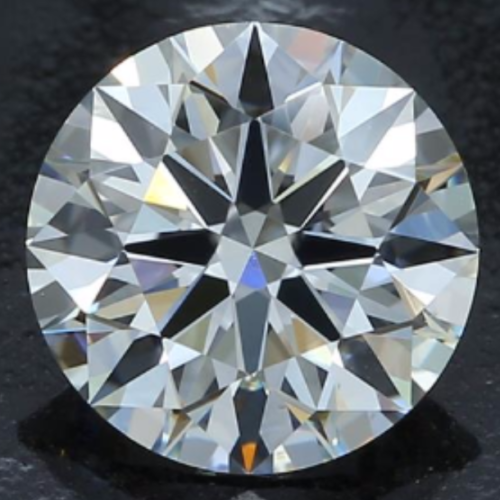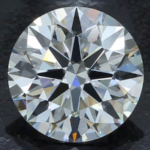
The Truth About D-E-F Colorless Diamonds
Trying to decide between which diamond color to buy presents most people with a confusing challenge. Our natural inclination is to focus our search on the high end of the color spectrum, which are colorless diamonds in the D-E-F range.
The challenge with D-E-F color diamonds of course, is that the absence of color makes the diamonds more valuable. Thus D-E-F color diamonds are more expensive than G-H-I color diamonds, which are considered to be near-colorless.
D-E-F colorless diamonds:
 Diamonds in the D-E-F color spectrum are commonly described as being colorless. This is because diamonds are graded for an absence of color, rather than the presence of color.
Diamonds in the D-E-F color spectrum are commonly described as being colorless. This is because diamonds are graded for an absence of color, rather than the presence of color.
This means that this 1.356 carat, D-color, VS-1 clarity, Black by Brian Gavin hearts and arrows diamond, should face-up whiter and brighter than a diamond that is lower in color. Speaking of which, diamonds which are closer to the D-color end of the spectrum are higher in color; and as we move down the spectrum towards Z-color, those diamonds are lower in color.
 Thus this 1.544 carat, E-color, VS-1 clarity, Black by Brian Gavin hearts and arrows diamond is technically lower in color than the D-color diamond. However, the reality is that most people would be hard-pressed to distinguish the difference between them.
Thus this 1.544 carat, E-color, VS-1 clarity, Black by Brian Gavin hearts and arrows diamond is technically lower in color than the D-color diamond. However, the reality is that most people would be hard-pressed to distinguish the difference between them.
In my experience, the only difference that you’re likely to see between these two Black by Brian Gavin diamonds, is the slight difference in carat weight. That is going to be much more apparent than the difference of one color grade.
On the same premise, the color difference between those diamonds and this 1.308 carat, F-color, VS-1 clarity, Black by Brian Gavin diamond will also be very slight. Most people are not able to easily discern between D-E-F color diamonds when viewed in the face-up position. This is because the incredibly high sparkle factor of Brian Gavin Signature diamonds, makes it harder for the eyes to clearly focus upon the body of the diamond.
G-H-I color diamonds:
 As with diamonds in the D-E-F colorless range, it can be difficult for people to easily discern the difference between diamonds in the G-H-I near-colorless range. However, I think that it is a little easier to do with lower color diamonds, than with diamonds in the higher color range. Especially when there is a difference of more than one color grade, like the difference between D-E and G-color for example.
As with diamonds in the D-E-F colorless range, it can be difficult for people to easily discern the difference between diamonds in the G-H-I near-colorless range. However, I think that it is a little easier to do with lower color diamonds, than with diamonds in the higher color range. Especially when there is a difference of more than one color grade, like the difference between D-E and G-color for example.
Thus, you might find it a little easier to see the difference between this 1.237 carat, G-color, VS-1 clarity, Black by Brian Gavin diamond, and the D-E color diamonds above.
 Or you might find it easier to tell the difference between that G-color diamond, and this 1.252 carat, I-color, VS-1 clarity, Brian Gavin Signature hearts and arrows round diamond. But I have to tell you, that the difference in the face-up position will still appear to be very slight to most people.
Or you might find it easier to tell the difference between that G-color diamond, and this 1.252 carat, I-color, VS-1 clarity, Brian Gavin Signature hearts and arrows round diamond. But I have to tell you, that the difference in the face-up position will still appear to be very slight to most people.
The difference between D-E-F vs G-H-I color diamonds is easier to see under laboratory grading conditions. When we grade diamonds for color in the gem lab, we’re looking at them upside down, from a side profile, under the controlled light of a GIA Diamond Light, in a room which is otherwise pitch black.
Environmental effects upon diamond color grades:
It is much easier to see the difference between D-E-F and G-H-I color diamonds, under the controlled laboratory conditions. Thankfully, we live in the real world, where diamonds are being exposed to a variety of lighting conditions, which change from room-to-room.
Which brings us to a very important realization, which is that our perception of diamond color is largely influenced by the lighting conditions in which we are viewing the diamond. Not only will our perception of color be influenced by the lighting environment, but they will also be influenced by the color of the prongs which touch the edge of the diamond, and the presence or absence of blue fluorescence.
When you stop to take these factors into account, you’re likely to see that the difference between D-E-F vs G-H-I color diamonds is very slight. Thus, you can feel confident buying any Brian Gavin Signature diamond in the colorless to near-colorless range.
In fact, the higher cut quality of BGD Signature diamonds, makes them the perfect choice for people who prefer diamonds in the J-K-L and warmer diamond color range as well. Because the proportions and higher degree of optical precision, create such intense sparkle factor, that it becomes more difficult to accurately judge the body color of the diamond in the face-up position.




















